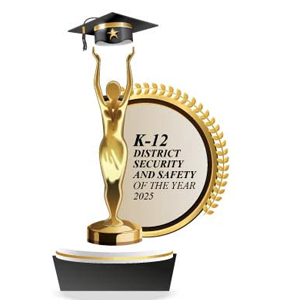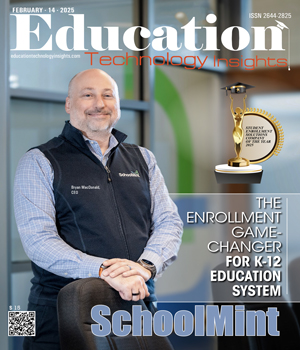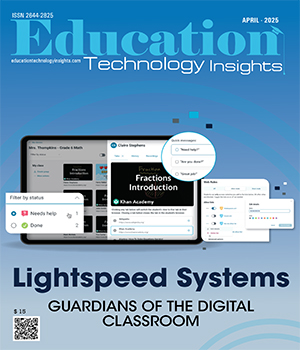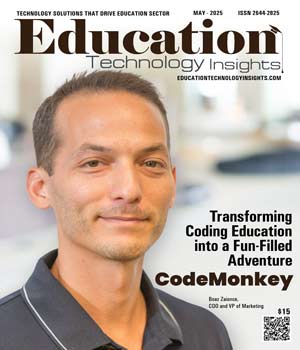THANK YOU FOR SUBSCRIBING
Be first to read the latest tech news, Industry Leader's Insights, and CIO interviews of medium and large enterprises exclusively from Education Technology Insights
Newer Possibilities in the Realms of Education Technology
Richard Walker, Head of Programme Design and Learning Technology, University of York
 Richard Walker, Head of Programme Design and Learning Technology, University of York
Richard Walker, Head of Programme Design and Learning Technology, University of YorkRichard Walker is an experienced professional in the learning technology sector, boasting a 30-plus year career spanning the evolution of virtual and managed learning environments. Having held research and teaching posts at Nyenrode Business University (Netherlands) and at the Euro-Arab Management School in Granada, Spain, he has publications on instructional design frameworks for blended learning in a variety of journals, as well as approaches to the institutional adoption of learning technologies and staff development techniques for online instruction. Walker has also been an active member of UCISA’s Digital Education Group, serving as Chair of the Group and project manager for multiple Technology Enhanced Learning Survey Reports throughout the 2010s.
In an interview with Education Technology Insights Europe, Walker introduces the University of York and how it adopts the latest learning technologies, emphasizes the need for creating genuine, real-world assessment, and looks into the potential of coming technologies like AI to change the face of education.
What technological shifts have you seen in the industry over your career?
In the realm of learning technology, my journey began in the 1990s, a time preceding the establishment of institutional services like virtual learning environments and managed learning environments. During those early stages, engagement with learners took shape through bulletin boards and discussion forums alongside static web pages for content delivery. As time advanced, the landscape witnessed the emergence of Web 2.0 and collaborative technologies, notably the semantic web. These innovations aimed to bolster learner agency, provide student control, and foster co-creation opportunities.
This progression marked a departure from the traditional top-down and managed technological approach, transitioning toward a paradigm that placed learner empowerment and co-creation at its core. Notably, emerging technologies, including intelligent agents and artificial intelligence, have ushered in new dimensions for personalised learning. The pursuit of granting learners greater control over their educational paths has been a longstanding endeavour.
Today, the field finds itself precisely where it has aimed to be. Learners now have an unprecedented degree of influence over their learning trajectories. The evolving landscape holds the promise of transformative outcomes as these technologies advance. Observing the unfolding of these developments remains a fascinating prospect, offering insight into the future trajectory of education and learning technology.
How does your experience and expertise in the domain help you augment your role as a head of program design and learning technology at the University of York?
I provide support for academic departments in program creation and curriculum development. I also oversee our portfolio of centrally backed learning technologies, tools, and services. It allows me and my team to work with academics, from crafting first principles and learning outcomes to thinking about active learning and where technology can play a more transformative role in supporting learner agency. This allows learners to develop and drive their education inside and outside the classroom.
It is beneficial that educational technology is not just presented in a technical sense but also deeply entwined with pedagogy and how technology is used in the curriculum to enhance student learning.
In my opinion, that is one of the main advantages of my job. Since we can link the dots between what we do to support students in realising learning outcomes and doing it meaningfully through technology, we are not merely perceived as individuals who can address technical problems.
What challenges have you faced in your efforts to make sure that technology has a transformative impact on students' learning?
One of the challenges, especially in the UK, is the government's intense pressure on institutions to abandon emergency remote teaching and return to more conventional campus-based education. During the pandemic and emergency remote teaching, a lot of good work was done to address the inclusive learning agenda and account for different student profiles, including part-time students with caring responsibilities, mature students, and becoming typical students by supplementing school with work.
"The onus is on educational institutions and higher education to shift their assessment practices toward authentic, real-world problems, and a more open assessment model that applies to industry and the workplace"
Based on that, we designed flexible learning pathways for our students, giving them more flexibility in the curriculum and how they should participate. Additionally, we moved away from a straightforward classroom attendance model and towards diverse ways that students may interact with the intended learning through technology. Therefore, the main challenge is how we continue to fulfil our commitments regarding campusbased teaching while also addressing that flexible learning requirement.
It's still very early on in terms of course innovation, but we've seen a shift towards high-flex course models since the emergency remote teaching phase. The future may revolve around further developing those models by examining how we can incorporate collaborative technologies to give students more choice over how they participate in a course by combining synchronous and asynchronous participation modes.
Please elaborate on the noteworthy innovations, trends, or technologies you employ to lessen these difficulties.
Educational institutions as a sector have made some sizable investments in collaborative technologies. Microsoft Teams is currently quite commonplace within the University of York's sector, to name a few. Slack is one of the tools we utilise to create a sense of community. For example, we have effectively used that for lab project work for project groups. However, we also utilise Zoom, Blackboard Collaborate, and other types of tools to help establish possibilities for collaboration and sharing of practice across peer groups across the institution.
What technology are you most looking forward to utilising, and where do you see the industry going?
How we handle generative AI tools like chat GPT and the integration of GPT-4 in Microsoft products is one of the prevalent difficulties in the current sector. It provides the opportunity to personalise learning and teaching and develop instructional content in various formats, significantly impacting the education industry. These challenge the established assessment paradigms like the traditional essay-based approach. An arms race is brewing between technologists who can detect the use of artificial intelligence in student work and the rate at which AI-related tools advance.
The onus is on educational institutions and higher education to shift their assessment practices toward authentic, real-world problems, and a more open assessment model that applies to industry and the workplace. Some of that work has already begun at the University of York, with a shift away from more conventional essay-based responses. As a result, my team has encouraged some fantastic work at our management school. For instance, switching from online assessments that involved essays on human resource management to assignments where students worked together using collaborative technologies like Blackboard to demonstrate and apply skills like interviewing tactics and staff development activities. These kinds of activities are used to evaluate how they apply threshold principles to specific tasks.
What advice would you give other senior leaders or CXOs in the educational technology domain?
One of the main issues we will face in the future is how we will prioritise system connections, usability, and, in particular, address the user journey. Therefore, working with students and emphasising the user experience when designing our digital systems and environments and how they affect the student journey is one of the main things we've done at York and we'll continue to do. Addressing accessibility issues and the user experience in design is essential, considering all types of learners. They are the guiding principles that form the basis of everything we have done and will do in the future.
Read Also
Our AI Crisis isn't Technical. It's Human.
4 Keys to Managing Change
Active Engagement is the Foundation of Effective Leadership
Empowering Leadership through Innovation in Higher Education
Redefining Readiness: A Path Toward a Technology-Agnostic Future
The New Era of Education

I agree We use cookies on this website to enhance your user experience. By clicking any link on this page you are giving your consent for us to set cookies. More info




















![Udemy [NASDAQ: UDMY]: Online Learning Transformed Udemy [NASDAQ: UDMY]: Online Learning Transformed](https://www.educationtechnologyinsights.com/company_logos/6-7cuaqksu.jpg)







